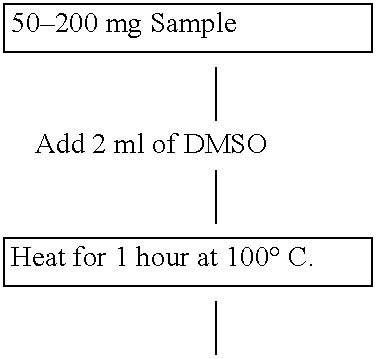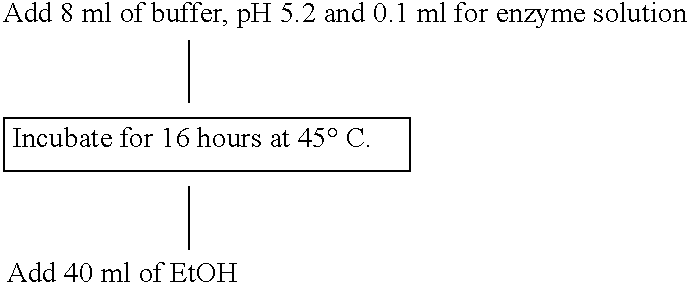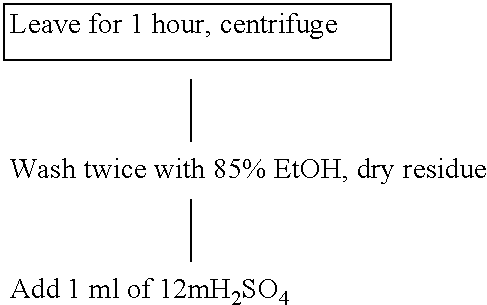Treatment of infection in animals
a technology for treating infection in animals and intestines, applied in the field of treating infection in animals, can solve the problems of reducing or eliminating treatment options, not all intestinal bacteria can metabolise non-digestible carbohydrates, and the ph of the large intestine/colon lumen decreases
- Summary
- Abstract
- Description
- Claims
- Application Information
AI Technical Summary
Benefits of technology
Problems solved by technology
Method used
Image
Examples
example 2
The Effect of Galactooligosaccharide (GOS) on the Survival of Campylobacter jejuni in a Model of the Canine Intestine
[0055] Method
[0056] The method used was as per Example 1 substituting FOS for GOS. The results from the individual experiments are shown in Table 2. GOS was from Borculo Domo ingredients (BDI).
[0057] Results
[0058] After a 24-hour microaerobic incubation, no viable Campylobacter jejuni cells could be recovered from flasks that had GOS added. In contrast, Campylobacter jejuni cells were recovered from the flasks that contained no GOS at around 10.sup.8 cells per ml. The results from the 6 individual experiments are shown in Table 2.
2TABLE 2 Numbers of viable Campylobacter jejuni cells (log.sub.10) recovered from the model of the canine large intestine with and without the addition of GOS. .rarw.----log.sub.10 colony forming units of Campylobacter jejuni ---.fwdarw. Faecal 0 hours 0 hours 24 hours 24 hours Sample +0.7% GOS NO GOS +0.7% GOS NO GOS GR1 7.28 7.23 0 8.71 L15...
example 3
The Effect of Coconut Endosperm Fibre on the Survival of Campylobacter jejuni in a Model of the Canine Intestine
[0062] Method
[0063] Investigation into the effect of coconut endosperm fibre on the survival of Campylobacter in the canine intestine.
[0064] Summary
[0065] Campylobacter is one of the most predominant gastrointestinal pathogens causing both clinical and non-clinical infections in dogs.
[0066] An in vitro model of the canine large intestine has been developed to test the effect of novel fibres on the survival of canine bacterial pathogens.
[0067] Inclusion of coconut endosperm fibre in this model resulted in the elimination of viable Campylobacter jejuni cells from the system.
[0068] Methods
[0069] Campylobacter jejuni cells were grown from stock cultures and cultured at 37.degree. C. under microaerobic conditions (5% O.sub.2, 10% CO.sub.2 and 85% N.sub.2). Liquid cultures were grown in 20 ml volumes in 50 ml conical flasks shaken on an orbital shaker. Overnight cultures grown i...
example 4
The Effect of Galactooligosaccharide (GOS) on the Survival of Salmonella enterica Serotype Typhimurium in a Model of the Canine Large Intestine
[0081] Salmonella is one of the most predominant gastrointestinal pathogens causing both clinical and non-clinical infections in dogs.
[0082] Shedding of Salmonella in faeces can continue for 3 to 6 weeks increasing zoonotic risk in humans especially young children.
[0083] An in vitro model of the canine large intestine has been developed to test the effect of non-digestible carbohydrates on the survival of canine bacterial pathogens.
[0084] Inclusion of GOS in this model resulted in the elimination of viable S. enterica serotype Typhimurium cells from the system. This translates to a reduction in shedding times of Salmonella in a host animal.
[0085] Studies were undertaken to determine whether the inclusion of the prebiotic galactooligosaccharide (GOS) in an in vitro model of the canine large intestine would have any effect on the survival of a ...
PUM
| Property | Measurement | Unit |
|---|---|---|
| weight % | aaaaa | aaaaa |
| weight % | aaaaa | aaaaa |
| volumes | aaaaa | aaaaa |
Abstract
Description
Claims
Application Information
 Login to View More
Login to View More - R&D
- Intellectual Property
- Life Sciences
- Materials
- Tech Scout
- Unparalleled Data Quality
- Higher Quality Content
- 60% Fewer Hallucinations
Browse by: Latest US Patents, China's latest patents, Technical Efficacy Thesaurus, Application Domain, Technology Topic, Popular Technical Reports.
© 2025 PatSnap. All rights reserved.Legal|Privacy policy|Modern Slavery Act Transparency Statement|Sitemap|About US| Contact US: help@patsnap.com



